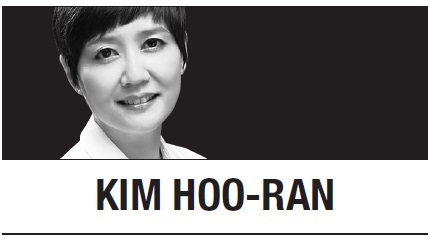The third summit between South Korean President Moon Jae-in and North Korean leader Kim Jong-un in Pyongyang last week had many Instagrammable moments.
There was the pomp and ceremony of Moon’s arrival at Sunan International Airport where he was greeted by Kim and his senior officials, ceremonial guards and a 21-gun salute. A motorcade through the Pyongyang thoroughfare saw the two leaders standing side by side in an open-top car waving at the crowds of people in colorful hanbok chanting “Unification of homeland” and frantically waving artificial flowers, North Korean national flags and unification flags.
The sight of the two leaders raising their clasped hands high as they posed for photos in front of Chonji, the crater lake of Paektusan, was a moving moment for many Koreans. The tallest peak on the Korean Peninsula has a special place in people’s hearts as the spiritual home of the Korean people.
Moon’s address to the 150,000 North Koreans gathered at the May 1 Stadium in Neungra-do, however, stands out as perhaps the most significant moment in his three-day trip to Korea. It was as dramatic as it was unprecedented. Kim introduced Moon to the crowd, saying that the two leaders produced results that will mark another milestone in the development of inter-Korean relations and the journey toward peace and prosperity.
This was yet another pivotal moment in South-North relations. For the first time ever, a South Korean president was directly addressing North Koreans. The momentous occasion must not have been lost on Moon, who said, “Together we are creating a new era.”
That new era is one of peace, he said. He credited Kim for his bold decision to take the path toward the new future.
No one could have imagined any of this a year ago. North Korea held its sixth nuclear test in September 2017. In November, it test-fired an intercontinental ballistic missile capable of reaching the US mainland.
As US President Donald Trump and Kim exchanged bellicose verbal salvos, Koreans and the rest of the world held their breath, fearing a violent clash that could lead to a cataclysmic war, quite possibly World War III.
Then came Kim’s New Year’s Day speech in which the North Korean leader said he would send a North Korean delegation to the PyeongChang Winter Olympics in February. Of course, that peace overture came after Kim reiterated the completion of his country’s nuclear and missile programs and urged the mass-production of the weapons.
That speech, nevertheless, led to a cascade of events that saw North Korean athletes competing in PyeongChang, a unified women’s ice hockey team and visits by delegations of high-ranking North Korean officials, including Kim Yo-jong, Kim’s sister, who delivered a letter from Kim, inviting Moon to Pyongyang.
Developments surrounding the Korean Peninsula have been taking place at a dizzying pace. Moon and Kim held their first summit in April, another a month later, followed by the first-ever summit between a US president and a North Korean leader in Singapore in June. Last week saw the third Moon-Kim summit in Pyongyang, as the denuclearization talks between the US and North Korea appeared to have hit a snag.
The Pyongyang Declaration reaffirmed North Korea’s commitment to denuclearization, lending momentum to the stalled talks. The declaration included North Korea’s pledge to permanently dismantle a missile test site and launch pad under the watch of international experts. Kim also declared his intent to permanently dismantle the Yongbyon nuclear facility, if the US takes corresponding measures.
On Monday, Moon met Trump in New York, filling him in on the details of his talks with Kim, details that were not included in the Pyongyang Declaration. Trump said he expects to hold a second summit with the North Korean leader “in the not too distant future.” In the meantime, a flurry of diplomatic efforts are underway to facilitate the second summit.
Back in Pyongyang, progress was more tangible on the inter-Korea relations front, with the two leaders signing a military agreement aimed at reducing military tensions along the border. The two leaders agreed that nuclear weapons and nuclear threats will be eliminated from the Korean Peninsula. The two sides discussed various inter-Korean economic projects. In a further bold step, Kim agreed to visit Seoul before the end of the year.
Instagram moments in Pyongyang and the talks of inter-Korean cooperation notwithstanding, it must be remembered that without North Korea’s complete denuclearization, it will all come to naught.
At Samjiyon Airport, on his way to Paektusan, Moon was greeted by a crowd applauding and chanting “Peace, Prosperity.” Kim has said repeatedly that his country is now focused on economic development. He knows full well that the international sanctions imposed on his country for its nuclear and missile provocations must be removed in order for him to realize the goal of economic development. Trump has said time and again that the sanctions will remain in place until North Korea denuclearizes. The inter-Korean economic projects discussed in Pyongyang will remain on the drawing board unless the sanctions are lifted.
Moon, as a facilitator, has done an admirable job of keeping the US-North Korea talks alive at critical junctures. However, nothing is done until it is done. Rather than get misty-eyed at the photos from Pyongyang, we should stay clear-eyed on one goal -- the complete denuclearization of North Korea.
Kim Hoo-ranThe writer is the general news section editor at The Korea Herald. She can be reached at
khooran@heraldcorp.com -- Ed.








